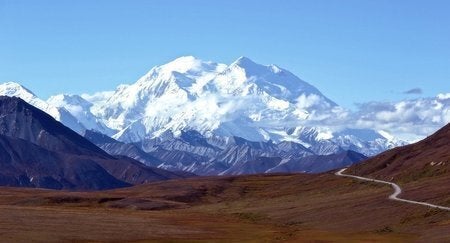
*Victoria Herrmann [2014] is a Gates Cambridge Scholar and Managing Director of the Arctic Institute. In 2016 she is traveling across America for a National Geographic -unded book titled America's Eroding Edges. Picture credit: Arctic Institute.
Over the past year as Arctic Council Chair, the United States has worked hard to remind the world, and itself, that America is an Arctic nation.
President Obama's visit to Alaska last autumn marked the first time in this country's history that a sitting president ventured across the Arctic Circle. In January, the National Academy of Sciences held Arctic Matters Day, an event that explored the ways American lives are tied to what is happening in 'that "isolated" part of the world'. And throughout 2016, the State Department is publishing a series of stories that share the reasons each state contributes to America's identity as undeniably the Arctic region does.
This latest rhetoric on being an Arctic nation goes beyond performative politics.
Through executive orders and federal policies, America has made tangible achievements in both Alaska and the region to address climate change since the start of its Arctic Council Chairmanship in April 2015. President Obama has committed to bringing much needed affordable, clean energy to remote Alaska communities through competitive grants and technical assistance programmes. And the Administration has endowed the Denali Commission to lead resiliency work throughout the state supported by federal programmes and funding resources.
All of this is not without merit. Renewable energy and resiliency are important in bolstering the capabilities of a forgotten last frontier at the frontlines of climate change. But America's recent Arctic policies and proposals suffer from the idea that Alaska's experience is unique, detached from the typical challenges and opportunities of the American climate experience.
Aptly showcased in the President's budget request to Congress, Obama proposed $400 million "to cover the unique circumstances confronting vulnerable Alaskan communities, including relocation expenses for Alaska Native villages threatened by rising seas coastal erosion, and storm surges".
But the circumstances confronting vulnerable Alaskan communities are not unique; they are being experienced throughout the United States today.
In the Chesapeake Bay, Tangier Island's shoreline recedes by about 14 feet a year. On Washington state's Olympic Peninsula, the Quinault Indian Nation relies on a 2,000-foot-long sea wall for protection until it can complete its move uphill. Over the last 10 years, the Isle de Jean Charles community in Louisiana has lost 98 percent of land and two-thirds of its residents to shoreline erosion. In 2016, they became the first federally funded community in the lower 48 to relocate due to climate change.
Beyond Arctic exceptionalism
As the United States marks the start of its second and final year as Arctic Council Chair this week, it must move beyond Arctic exceptionalism in its climate policies to create a legal and financial structure that can adequately respond to all American communities in need of relocation.
President Obama's $400 million proposal is a necessary step forward, but it falls short of any real impact. In Alaska alone, climate change flooding and shoreline erosion already affects more than 180 villages, 31 of which are in "imminent" danger of becoming uninhabitable. At an estimated cost of $100 to $200 million per relocation, Obama's proposal covers less than 15 percent of only Alaskan towns.
Across the United States, 414 towns and cities will eventually be under water no matter how much humans decrease carbon emissions. At the minimum, this equates to 4.3 million Americans displaced from their homes by 2101, according to low-end NASA sea level rise predictions. At the high-end, over 13 million people along America's coastlines will embark on a great migration inland.
These hundreds of communities that must make the incomprehensible decision of leaving their homes, livelihoods and lives they once lived behind should be supported throughout the difficult process of voluntary relocation. And yet, as they stand today, federal programmes for disaster assistance are limited and mostly unavailable to towns that require climate-induced relocation. Relief programmes focus on sudden natural disasters like Hurricane Sandy and on rebuilding in place, not on financially supporting the relocation of towns facing gradual inundation from rising tides.
Because of this, coastal communities are burdened with not only choices of what to save but also how to pay for relocation within an inflexible, complex federal system. Across the country towns must rely on ad hoc funding, similar to those proposed by Obama under the Arctic Council Chairmanship, to rebuild and relocate in bits and pieces, in the hope that the work will be done before an emergency evacuation is needed.
Sharing experiences
These programmes must be adapted to ensure that communities making the difficult decision to voluntarily relocate from shoreline erosion can do so in the most painless way possible. As a first step, President Obama's Arctic Executive Steering Committee can use the motivation of the Arctic Council Chairmanship in 2016 to invite Alaskan local leadership from towns like Shishmaref and Kivalina to Washington, DC to share their challenges and successes in Arctic relocation to inform a national policy change. Using the Alaskan convention of relocation leaders as a catalyst, a follow-up Steering Committee meeting can convene stakeholders from across coastal America to draft a framework for relocating coastal communities in danger across the United States.
Through both rhetoric and action, America has proven that it is an Arctic nation in its first year as Arctic Council Chair. But what President Obama has yet to prove is that Alaska's Arctic is not some '"isolated" part of the world.' Alaska may be the Arctic, but it is also American, burdened with the same climate challenges we all will face in the decades to come. As year two of its Arctic leadership begins, its high time America moved past Arctic exceptionalism to connect Alaska's relocation experience with the millions of Americans that will ultimately retreat inland from sea to rising sea.
